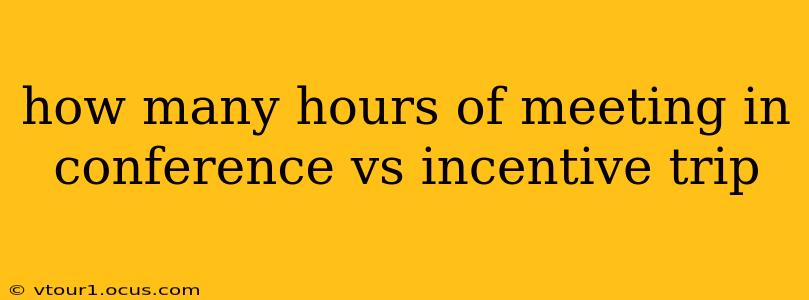Conference vs. Incentive Trip: A Comparison of Meeting Hours
Planning a corporate gathering? The choice between a conference and an incentive trip significantly impacts meeting time, alongside overall objectives and budget. While both involve bringing people together, the purpose and structure dramatically differ, leading to vastly different meeting hour allocations. Let's break down the key differences.
What's the Difference Between a Conference and an Incentive Trip?
A conference is typically focused on education, networking, and information sharing. Think presentations, workshops, keynote speakers, and breakout sessions. The primary goal is to disseminate knowledge, build professional connections, and potentially generate new business leads.
An incentive trip, on the other hand, rewards high-performing employees or distributors. The focus is on recognition, team building, and motivation. While there might be some structured meetings, the emphasis is on relaxation, celebration, and fostering stronger relationships within the group.
How Many Meeting Hours Can You Expect?
This is where things diverge significantly. There's no single answer, as the duration of meetings depends on the specific event's agenda and goals. However, we can offer some general guidelines:
Conferences:
- Typical Meeting Hours: Conferences often involve multiple days with a substantial portion dedicated to structured meetings. Expect anywhere from 6 to 12 hours or more of formal sessions across the entire event. This can include keynote speeches, panel discussions, workshops, and networking sessions that incorporate elements of presentations and discussions.
- Variations: The intensity varies significantly. A short, focused conference might only have a few hours of meetings per day, while a larger, multi-day event could easily fill the entire schedule with sessions.
Incentive Trips:
- Typical Meeting Hours: Incentive trips usually have far fewer formal meeting hours. Think 1-3 hours total across the entire trip. These might involve brief welcome addresses, team-building activities with debriefs, or strategy sessions.
- Variations: The amount of scheduled meeting time heavily depends on the company's goals. Some companies might integrate more strategic sessions, while others prioritize purely recreational activities.
What Factors Influence Meeting Hours?
Several factors influence the number of meeting hours for both types of events:
- Event Length: A longer event will naturally have more potential meeting time.
- Event Objectives: A conference focused on intensive training will have more meeting hours than one primarily focused on networking. Similarly, an incentive trip focused on strategic planning will include more meetings than a purely celebratory event.
- Attendee Roles: The involvement of senior management or key decision-makers can increase the amount of structured meeting time needed for both conferences and incentive trips.
- Budget: A larger budget often allows for more comprehensive programming, potentially leading to more meeting hours for conferences. For incentive trips, a larger budget might allow for more luxurious amenities, potentially reducing meeting time.
Frequently Asked Questions (FAQs)
H2: What is the average length of a conference?
The average length of a conference varies greatly, ranging from a single day to several days, even a week or more for large-scale events. The duration directly impacts the potential meeting hours.
H2: How many days is a typical incentive trip?
Incentive trips typically last from a long weekend (3-4 days) to a full week, depending on the company’s budget and the reward structure. The length influences the amount of time allocated to both meetings and recreational activities.
H2: Are there any benefits to shorter meetings in incentive trips?
Shorter meetings in incentive trips promote more relaxed engagement and allow more time for team bonding, celebration, and overall enjoyment of the trip's benefits. This can foster better team cohesion and morale.
H2: Can I incorporate both conference-style and incentive-trip elements into a single event?
Yes, absolutely! A hybrid event that blends learning and celebration is a popular choice. It might feature shorter, more focused sessions interspersed with recreational activities, striking a balance between professional development and reward.
In conclusion, the number of meeting hours varies considerably between conferences and incentive trips. Conferences prioritize knowledge sharing and often include extensive structured meeting time, while incentive trips focus on reward and team building with minimal formal meeting hours. Careful planning and clear definition of goals are crucial in determining the optimal meeting schedule for either type of event.
